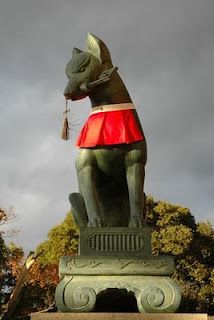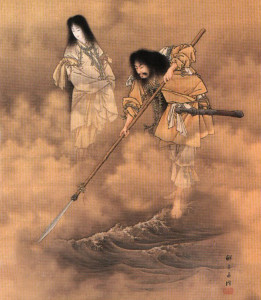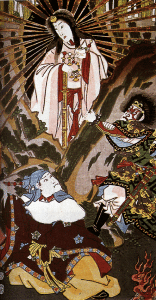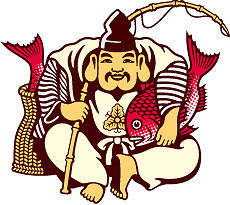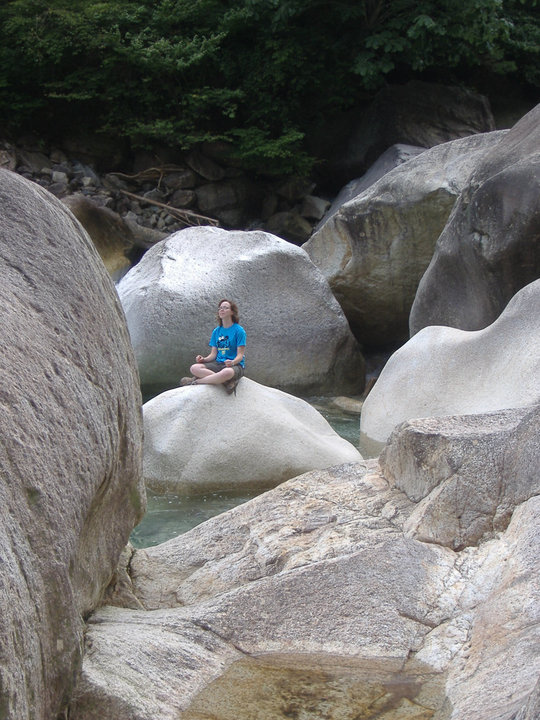A Brief Unscholarly Intro to Shinto Gods
While for most of us October is the Month of Halloween, on the Shinto calendar it is the Month Without Gods. That’s because they are all at Izumo Taisha in Shimane Prefecture deciding on your love life for the coming year! But who are these gods? And where are they when they’re not matching up dating profiles? With all the shrines in Japan (and the tendency for everything to be in Japanese), it can be a little confusing. Hopefully this guide, gleaned from two years of shrine visits and Google searches, will give you a leg up when you want to go pray for those perfect test scores, your one true love, or just lots of money. Since the Shinto gods are uncountable—and include everything from mountains and trees to still living people—I’ll be focusing on just a couple that I run into the most.
Thanks to a long and colorful history, the deities enshrined at most places are often mixtures of Shinto gods, historical figures, and Buddhas! I’m not quite sure how; the process of Shinto-Buddhist syncretism goes over my head. So please forgive me for sacrificing complex truths in favor of simplicity in this guide!
Tidbit: This brother and sister couple gave birth to the islands of Japan (Hyogo’s own Awajishima was the first!). Though they gave birth to many, many, many gods, their relationship was not without strife: after Izanami died giving birth to a fire god, Izanagi went to the underworld to retrieve her. But when he saw that being dead hadn’t improved her looks any, he high-tailed it out of there. Izanami swore to kill 1,000 people a day as payback, so Izanagi replied that he would give life to 1,500 a day.
Gods of: creation, life, death
Notable shrine: Izanagi shrine on Awajishima, said to be built on the sight where Izanagi lived as a mortal after leaving Japan to Amaterasu.
Tidbit: Embodiment of the sun and mother of the imperial family. After her brother destroyed some of her stuff (and threw a dead horse at her loom???), she locked herself away in a cave. The world was in pretty bad shape without the sun, so the goddess Ame no Uzume came up with a plan. The plan was to perform a strip tease. The noise of the other gods’ cheering successfully lured Amaterasu out, and all was well.
As her direct descendant, the Emperor of Japan spends a big part of his year in Shinto ceremonies!
God of: the sun
Notable shrine: Ise Jingu in Mie Prefecture
Susano-o
Tidbit: Amaterasu’s brother. He’s the one who pissed her off so much she hid in a cave. He didn’t act like an asshole all the time (though he got kicked out of heaven for being a jerk) and he killed an eight-headed serpent that had been plaguing the people in current-day Shimane Prefecture. He killed it by getting it really, really drunk.
God of: seas, storms
Notable shrine: Yasaka Shrine in Kyoto, home of the month long Gion Matsuri in July
Inari
Tidbit: Inari’s gender is unknown/non-existent. Representations of this god depend on the area, and range from young women to old men. You can always recognize Inari shrines by the guardian fox statues (other shrines will have guardian dogs). Inari shrines are the most common type of shrine.
God of: rice, agriculture, fertility, sword smiths
Notable shrine: Fushimi Inari Taisha in Kyoto
Â
Hachiman
Tidbit: Hachiman shrines are the second most popular type of shrine. Hachiman was the god of the Minamoto (Genji) clan, the founders of the Kamakura period. Because of Hachiman’s association with warriors, the enshrined object is often a stirrup or a bow.
God of: war, warriors, archery
Notable shrine: Iwashimizu Hachiman shrine in Kyoto Prefecture (not the city!)
Sugawara Michizane
Tidbit: A scholar from the Heian period, he was unfairly persecuted, and thus was enshrined after his death in order to put a stop to plagues caused by his angry spirit. The moral of this story is that if you want people to worship you after you die, you should haunt them. Writing brushes are often used as enshrined objects, and once I saw a shrine were hopeful scholars could leave their used brushes (or pens or pencils) as offerings! His shrines can be recognized by bull statues, plum trees, and hoards of stressed out students preparing for entrance exams.
God of: students, scholarship
Notable shrines: Kobe’s Kitano area has a small shrine dedicated to Sugawara. There is also a larger one in Osaka, home of the famous Tenjin Matsuri.
Â
Tidbit: You can recognize Ebisu because he is the fat laughing guy holding a fish. His is one of the Seven Lucky Gods, and the only one to have originated in Japan, rather than China or India. He is especially popular in Kansai because he is a friend of merchants. You will often see his image incorporated at fugu restaurants! His festival at the Nishinomiya shrine on the 9th and 10th of January starts with a race: first one to smash into the giant sake barrel is the Lucky Man of the year!
God of: fishermen, prosperity, luck
Notable shrine: Nishinomiya Ebisu shrine in Hyogo, just 10 minutes from my school :J
Jillian MacKenzie
